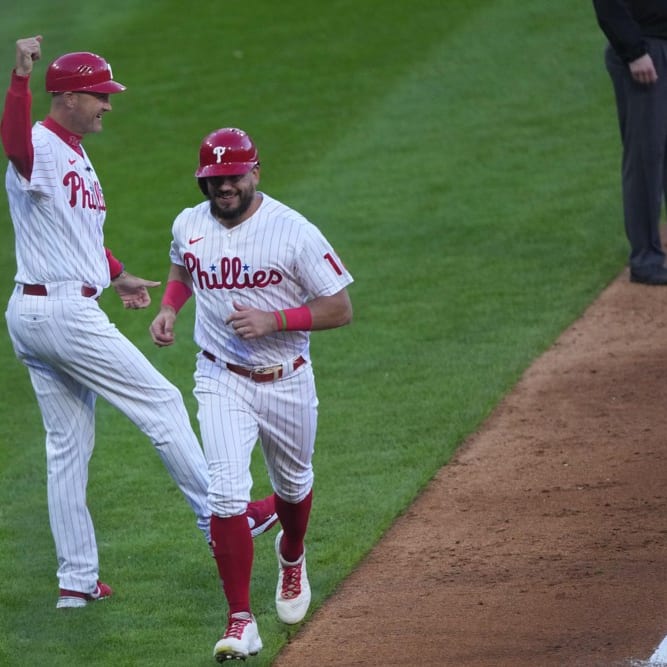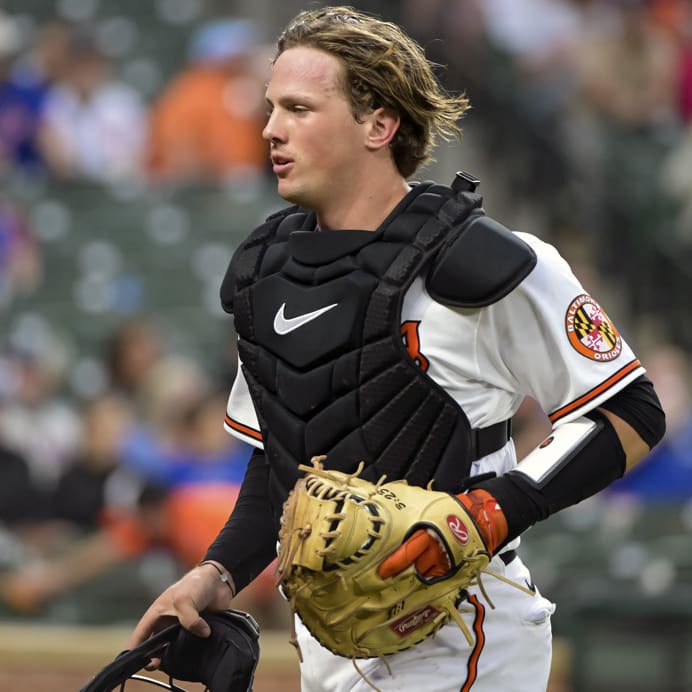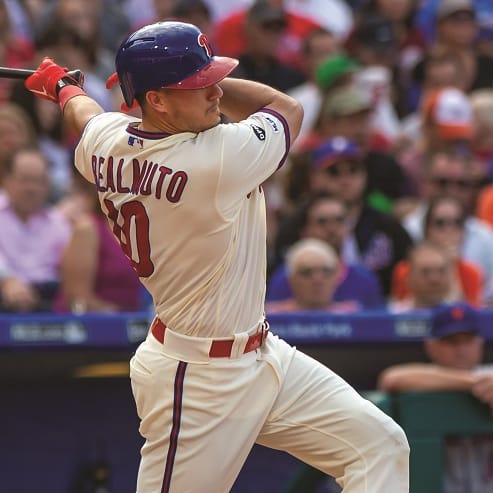This article is part of our Regan's Rumblings series.
In a new feature for RotoWire this year, "Behind the Numbers," I'll take a statistical/sabermetric approach to helping you win your leagues. While I watch actual games about as much as anyone, at the same time, numbers have always fascinated me. From the numbers on the backs of baseball cards that I started collecting as a kid in the late-70s (and still do today), to rolling dice on my porch with my cousin playing Strat-o-Matic baseball, numbers have always been a part of my obsession with this great game. Now with the vast reams of data courtesy of Baseball Info Solutions to the great analysis being done on this and other sites, it's imperative that fantasy owners continue to not only base their roster construction on what they see in games and box scores, but also on underlying statistical metrics such as xFIP, K%, HR/FB% rate and countless others. That is what we will do here all year.First up, observations on a handful of players whose cheat sheet rankings appear to be causing the most debate this spring.
Yasiel Puig, OF, LAD
Perhaps the most polarizing player in recent years, Puig can be both a force between the lines as well as cause his manager to pull out his hair. Puig was 3-for-5 in the season's second game in Australia on Saturday, but a pair of baserunning gaffes resulted directly in outs. It's a theme we saw last year, and one that appears to be out in full force early in 2014. At first glance, a triple slash of .319/.391/.534 with his age, speed and upside screams "second round pick," but I just can't go there for a few reasons:
• Competition – Matt Kemp (ankle) appears to be in line to make his 2014 debut Sunday in San Diego, giving the Dodgers, at least for now, four healthy outfielders. It's not a stretch to think that if Puig's wild ways continue, he could find himself on the bench more often than his talent warrants.
• 2013 finish – Puig batted just .214 over the season's final month. Was he just tired or did pitchers figure some things out?
• Out of shape? – Puig reported to camp 26 pounds over the weight at which he ended last season, and by what I saw in Arizona up close, it wasn't all muscle. Sure, he's probably lost some (most?) of that by now, it makes one possibly question his motivation.
On the plus side, Puig seemed to take a more patient approach as the season wore on last year, posting a 0.48 K/BB rate after the All-Star break versus that of 0.19 prior. His arm in right field is also such a weapon that sitting him has an impact in both halves of the inning. I'd still draft him, but more in the 4th/5th round range than as a second-round pick.
Robinson Cano, 2B, SEA
Is Cano being punished too much for the move out of New York to Seattle? Sure, it's not as good of a lineup and the hitting environment can be challenging, but instead of being a lock to be a top-five pick again this year, Cano is going more in the 10-15 range in the drafts I've seen. He's even going after Jason Kipnis among second basemen in some drafts, a direct result of his new team. Did Cano benefit from a solid Yankees lineup and a home park favorable to left-handed power hitters? Sure, but he was also no slouch away from Yankee Stadium.
Road Stats:
2013: .303/.366/.523
2012: .321/.397/.520
2011: .310/.348/.533
He has a .936 OPS in 52 at-bats the last three years at Safeco Field, though that is probably statistically insignificant. We could talk about the lack of "protection" in his new lineup, but Cano was just fine last year batting in a lineup that hit a collective .242, was decimated by injuries (Alex Rodriguez, Mark Teixeira, Derek Jeter, Curtis Granderson, etc.) and that received at least 300 PA from the likes of Vernon Wells, Chris Stewart, Eduardo Nunez and Lyle Overbay. This guy is going to hit and be a top-five fantasy player this year.
Jonathan Villar, SS, HOU
Carlos Correa may or may not be the shortstop of the future depending on how he develops defensively, but the rebuilding Astros have a pretty intriguing player now. Between Triple-A and Houston a year ago, Villar swiped 49 bags, while batting .243/.321/.319 in 241 big-league PA. He totaled 20 home runs the last two seasons, though we're probably looking at single digits at the big-league level. That said, you're not drafting Villar for his power, but his ability to steal bases. Villar is never going to hit for much of an average, however, as witnessed by his K% rates the last few seasons:
| YEAR | PA | K | K% |
| 2009 (R/A-) | 155 | 38 | 24.5 |
| 2010 (A-/A+) | 563 | 153 | 27.2 |
| 2011 (A+/AA) | 574 | 156 | 27.2 |
| 2012 (AA) | 377 | 87 | 23.1 |
| 2013 (AAA/MLB) | 627 | 164 | 26.2 |
We can accept those rates if Villar were a slugger in the Chris Davis mold, but Villar has a career 51.4 AB/HR rate that we don't see improving dramatically in the near future. It seems likely that Dexter Fowler will see most of his at-bats in the leadoff role given Villar's propensity for the strikeout, but at the same time, Villar walked in 10 percednt of his PA for the Astros last year and has no real competition at his position for now. If Villar can improve his contract rate, maintain a solid walk rate and be more efficient on the basepaths (69 percent success rate), he can be a huge fantasy steal. I seem to have him on a number of teams this year, for what that's worth.
Brandon Moss, 1B, OAK
Moss qualifies at first base, but he is expected to see most of his playing time at DH while Daric Barton handles first base versus right-hand pitching. Moss has been GM Billy Beane's latest revelation, knocking 51 balls out of the yard the last two seasons (30 in 2013) after bouncing around the Red Sox, Phillies and Pirates organizations the previous six seasons. At 30, Moss is a bit older, but if you're looking for this year's Chris Davis, he could be your guy. He's batting .389 with three homers this spring, and here is how the two compare over the last four seasons in terms of home runs per plate appearance:
| YEAR | DAVIS | MOSS |
| 2010 | 38.7 | 26.5 |
| 2011 | 14.8 | 22.3 |
| 2012 | 17 | 14.1 |
| 2013 | 12.7 | 16.8 |
Davis obviously took a huge leap last year, bashing 53 home runs and receiving MVP votes. Moss had a similar PA/HR rate in 2013 that Davis did in 2012 before going nuts, so could we see the same thing here?
The first question is how many at-bats we can expect from Moss. He hit just .200/.261/.388 against left-hand pitching last year, but he did have a .770 OPS against southpaws in 2012. Digging deeper, Moss batted a respectable .269/.362/.471 in 128 PA versus lefties in Triple-A in 2011 and a less-than stellar .247/.298/.416 in 84 PA in 2012 for Triple-A Sacramento. The data suggests that while it may not be a strict platoon, Moss may be a longshot to approach 600 PA given his challenges against left-handers. Given all that, Moss probably won't pull a Davis and hit 50-plus homers, but 40? Very reachable.
Desmond Jennings, OF, TB
Jennings entered 2013 with lofty expectations as B.J. Upton's replacement in center field, and while he had a better season than the departed Upton, a .252/.334/.414 performance fell below expectations. Jennings did hit a career-high 14 homers, but his SB total dropped from 31 to 20. Jennings showed incremental growth in some areas, improving his walk rate from 8.2 to 10.6 percent and his strikeout rate from 21.3 to 19.1 precent year over year. In addition, 38.3 percent of his hits went for extra bases versus 31.5 percent in 2012 while he swung at fewer pitches outside the strike zone.
Jennings is expected to be an everyday player from day one this year after losing time to David DeJesus down the stretch last season. There appears to be no real threat to his playing time for the moment, as Matt Joyce should be the primary DH alongside an outfield of DeJesus, Jennings and Will Myers. Jennings, though, will need to prove he's improved against right-handed pitchers, against whom he batted just .231/.311/.386 last year. If Jennings can bump his contact rate above 80 percent this season (78 percent in 2013), he could approach a .270 average and perhaps a .350 OBP. There's certainly the potential to do so as he enters that magical age 27 season.
Jason Heyward, OF, ATL
I had just rostered Justin Upton at $44 in my 10-team NL-only keeper league auction last weekend, when Heyward was the next name brought up. He ended up going for $49, which at the time seemed like a massive overpay, but it made more sense given how few high-end options were left. Outfield seems to be a thin position this season, as evidenced by my late purchases of an injured Cody Ross and a fourth outfielder in Gregor Blanco.
So back to Heyward. I thought it was telling that this winter, the Braves chose to lock up Freddie Freeman, Craig Kimbrel, Julio Teheran and Andrelton Simmons to contracts of at least four years while Heyward received only a two-year deal to cover his final two seasons of arbitration eligibility. That said, while those four players' careers are on the rise, Heyward's appears stuck in neutral. Since finishing second in the NL Rookie of the Year voting in 2010 after batting .277/.393/.456 as a 20-year-old, Heyward has failed to top a .269 average and he managed just 14 home runs a year ago while dealing with a pair of freak injuries (broken jaw, appendectomy). Here, though, are a few reasons why I expect a huge turnaround in 2014:
• He showed up in great shape this spring. OK, we hear that a lot, but it's better than showing up in Yasiel Puig shape, right?
• He's only 24 ... with four full years of big league experience no less.
• Great pedigree. Heyward was once one of baseball's elite prospects, so we know the talent is there.
• The metrics. Heyward compared to 2012 improved his walk rate from 8.9 to 10.9 percent while cutting his strikeout rate from 23.4 percent all the way down to 16.6 percent.
• BABIP. Last year's .281 compares unfavorably to his .305 career mark. Bump it up to .300 and he should easily bat .270-plus.
• Solid spring. Through Monday's action, Heyward was batting .304/.371/.518 with three home runs this spring. He seems to be seeing the ball well.
• Injuries. Safe to say that being plunked in the jaw by a 90-mph Jonathon Niese fastball will do some damage physically and mentally. Now that he's 100 percent and that is in the past, Heyward should be fine.
• Improvement versus southpaws. In 2012, Heyward struggled mightily versus LHP, batting just .224/.281/.354. He improved that to .264/.346/.455 last year, making it clear that he's not a platoon guy.
Heyward is likely going to slot in the leadoff role initially, limiting his RBI opportunities but increasing his chances at scoring 100-plus runs and stealing 20-plus bases. As you probably guessed, I'm very bullish on him this season.
Matt Cain, SP, SF
While new No. 1 starter Madison Bumgarner tossed 17 scoreless innings with a 16:2 K:BB this spring and looks like the second best lefty in the National League, Cain is sporting a 5.91 ERA after a disappointing 2013 campaign. So what happened last year and what can we expect in 2014? Let's look at a few questions surrounding the Giants' former Opening Day starter.
• Did he lose velocity? No, that wasn't the issue.
Average Fastball Velocity:
2010 - 91.6
2011 - 91.2
2012 - 91.2
2013 - 91.2
• Did he lose his control? Maybe a little, but it wasn't a huge issue.
Walk Rate:
2010 - 2.5
2011 - 2.6
2012 - 2.1
2013 - 2.7
• Was it just bad luck?
When a pitcher has a down season as Cain did in 2013, one thing to immediately look at is how his ERA compares to his xFIP, which attempts to isolate those things that the pitcher truly can control (walks, strikeouts, home runs). An xFIP well under actual ERA can indicate that a pitcher really pitched better than his overall results (W/L, ERA) would indicate.
Here are how Cain's number stack up the last four seasons:
| YEAR | ERA | xFIP |
| 2010 | 3.14 | 4.00 |
| 2011 | 2.88 | 3.78 |
| 2012 | 2.79 | 3.82 |
| 2013 | 4.00 | 3.88 |
Looking at xFIP, Cain has been fairly consistent, including last season. Cain's HR/FB rate increased to 10.8 percent last year versus a career mark of 7.2 percent, so it's possibile that his home runs trend back down in 2014. Assuming he's still the same pitcher at age 29 that he was last year at 28, it's safe to project another sub-4.00 ERA, but if you go by his xFIP trends, a sub-3.00 mark may be wishful thinking. It seems safe to split the difference and go with a 3.50 mark.
Homer Bailey, SP, CIN
Much of the consternation around how to value Bailey this year is around the Reds giving him a $105 million contract this offseason. Fact is, he took a huge step forward in 2013, posting a career-high 8.6 K/9 while staying healthy enough to post his second consecutive 200-inning season. As he's matured, Bailey has also found above average control with a 2.3 BB/9 versus the 4-plus marks he posted in his first few tastes of big-league hitters back 2007-2009.
Can Bailey maintain his 2013 pace and perhaps even build on that season? I think he can, but I see three key success factors that will need to be met:
• Maintaining his velocity. The average velocity on Bailey's fastball spiked to 94.1 mph last year versus marks in the 92.2-92.8 mph range the previous three seasons. There is a huge difference between a 92.5 mph fastball and one that exceeds 94, and that was reflected in his improved strikeout rate.
• Control. The elite control appears to be real and sustainable, as Bailey's walk rates have been remarkably consistent the last three seasons – 2.3 each year.
• Keep the ball down. Great American Ballpark tends toward being friendlier to hitters than pitchers, so Bailey must do a good job keeping the ball down. It would help if he could work to duplicate his 2013 road groundball rate (48 percent) at home, where the mark fell a bit to 43.6 percent.
Bailey turns 28 in May, so he's right in the beginning of his prime years and with health concerns apparently in the past (65 starts the past two seasons), it's possible he could at least be in the Cy Young discussion at some point in the next handful of years.
Quick hits
Jacoby Ellsbury is being drafted in the 10-13 range in a lot of drafts based on the move to Yankee Stadium and probably the fact that simply, he's a Yankee. I'd be wary of drafting him that high given his medical history and the poor track record of basestealers post-30 years of age. ... Masahiro Tanaka is another who scares me (sorry Yankees fans) given his absurd workload in Japan. He can either be Yu Darvish or Daisuke Matsuzaka. ... I get positional scarcity and all, but I'm not taking Jason Kipnis over more established players like Joey Votto, David Wright and Prince Fielder. I want to see whether Kipnis can do it again. ... Has there ever been a more boom or bust pick than Billy Hamilton? He could post a .320 OBP and steal 70 bases or he could be overmatched and find himself in Triple-A by June. I lean more toward the former, but there is some bust potential here. ... Starling Marte is probably a solid fourth-round pick, but if he can improve versus RHP (.254/.315/.409 in 2013), he can be a top-10 fantasy player. The Pirates just invested $31 million in Marte, so they clearly think he'll be OK. ... Yoenis Cespedes seems to be hitting better late in spring. I really think he can go .270-35-120 this year. ... Perhaps it's because he's stuck in Florida, but Giancarlo Stanton was once a borderline first-round pick, right? Now he's in the 25-35 range, so there's value potential there. Stanton looks healthy this spring with a 1.009 OPS and five home runs.












